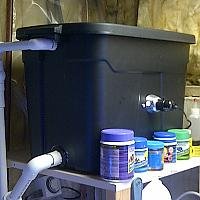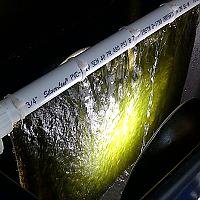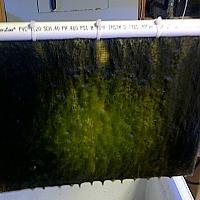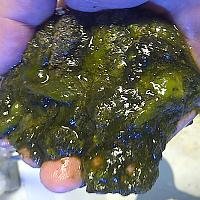You are using an out of date browser. It may not display this or other websites correctly.
You should upgrade or use an alternative browser.
You should upgrade or use an alternative browser.
Algae Scrubber Basics
- Thread starter srusso
- Start date
Floyd R Turbo
Either busy or sleeping
I was also responding to jb's question above my post, so it was for everyone's information really. Plus I didn't see your comment so I thought he was just trying to think ahead for his build.
IIRC Cyano likes red light, and many times when it's in the DT it's because of the lights being too old and shifting spectrum. So it makes sense that it would grab hold in the sump, and I saw this on my original scrubber which had no light blocking. When I added blocking to knock the light down into the sump, it went away very quickly. It wasn't 100% blocked, but apparently it was enough...
IIRC Cyano likes red light, and many times when it's in the DT it's because of the lights being too old and shifting spectrum. So it makes sense that it would grab hold in the sump, and I saw this on my original scrubber which had no light blocking. When I added blocking to knock the light down into the sump, it went away very quickly. It wasn't 100% blocked, but apparently it was enough...
Floyd R Turbo
Either busy or sleeping
It depends on what the configuration of your scrubber and sump is. The easiest way is probably to use a couple small sheets of black acrylic/polycarbonate or ABS plastic and place them on either side of the screen below the lights and above the water, and rig up something to support them. If you had a sketch of pictures of your setup or proposed setup that might help.
redneckgearhead
Active member
What do you think the best way for me to add some more light to this screen would be? Right now I have two CFl's on it from what I remember they are 23w so I am at 46 watts for a 90 gallon.
Here is a picture of the current set up.

Can you get a "splitter" like on post #1661 and run two bulbs in each lamp?
Floyd R Turbo
Either busy or sleeping
That really only works for the CFL floodlights, and those do not throw out as much light as the dome reflector (coverage is very focused).
It looks like it would not be simple, but you could put one dome high left pointing down at an angle, then another low right (like clamped to the side of the sump) pointing sideways. You would lose a little efficiency per lamp as they would not be pointing directly at the screen, but you would get more lumens thus better growth.
The other option would be to go with the smaller reflectors, you wold be able to get them closer to each other and more vertically stacked, but then you lost a little sideways coverage.
You could also try to put 2 lamps horizontally oriented (sideways) and do curved reflectors behind them. But this would require a lot more rework than either option above.
I would try the first one, with the larger reflectors
It looks like it would not be simple, but you could put one dome high left pointing down at an angle, then another low right (like clamped to the side of the sump) pointing sideways. You would lose a little efficiency per lamp as they would not be pointing directly at the screen, but you would get more lumens thus better growth.
The other option would be to go with the smaller reflectors, you wold be able to get them closer to each other and more vertically stacked, but then you lost a little sideways coverage.
You could also try to put 2 lamps horizontally oriented (sideways) and do curved reflectors behind them. But this would require a lot more rework than either option above.
I would try the first one, with the larger reflectors
Floyd R Turbo
Either busy or sleeping
I think Srusso will chime in here, but he has commented that the type of fixtures he uses are not very good at spreading the light out. It would be better to DIY a reflector, even one out of a beer can, or something like one. The point is to use as big of a reflector as possible. It wouldn't be too hard to do that and still use the clip-on light.
Snookster
New member
UPDATE - 3 months in. Cyano is all but gone. I threw a bunch of tech M in and 99% of bryopsis has gone away. Still have some dark green stiff stuff in one spot, but the snails seem to enjoy it, so no worries on it.
I'm harvesting about a cup a week and my screen is growing at least 3 different types of algae. I'm cleaning the glass about once a week, mostly a light film. I took the skimmer offline last week for a vinegar bath and forgot about it. I've actually noticed since then, my zoas have really been happier. I'm thinking I've leave it out for now and watch closely. So far, so good.
I'm harvesting about a cup a week and my screen is growing at least 3 different types of algae. I'm cleaning the glass about once a week, mostly a light film. I took the skimmer offline last week for a vinegar bath and forgot about it. I've actually noticed since then, my zoas have really been happier. I'm thinking I've leave it out for now and watch closely. So far, so good.
srusso
Active member
UPDATE - 3 months in. Cyano is all but gone. I threw a bunch of tech M in and 99% of bryopsis has gone away. Still have some dark green stiff stuff in one spot, but the snails seem to enjoy it, so no worries on it.
I'm harvesting about a cup a week and my screen is growing at least 3 different types of algae. I'm cleaning the glass about once a week, mostly a light film. I took the skimmer offline last week for a vinegar bath and forgot about it. I've actually noticed since then, my zoas have really been happier. I'm thinking I've leave it out for now and watch closely. So far, so good.
Glad to hear it, thanks for posting.
TheFishMan65
New member
srusso, rather than mylar (I assume the heat is the problem) have you tried/considered vet tape? I think it is aluminum and designed to take heat. So place I have seen it very close the the heating elements (and maybe on the gas vents).
srusso
Active member
srusso, rather than mylar (I assume the heat is the problem) have you tried/considered vet tape? I think it is aluminum and designed to take heat. So place I have seen it very close the the heating elements (and maybe on the gas vents).
I could use that, but at $20 a roll I am not running to the store to get it. Besides, rather then just throwing the chip bags away. A few of them get a second chance to be useful. Also Mylar is super reflective...
milkman55
New member
Updated ATS
Updated ATS
I saw several areas that I could improve on my first ATS, so I re-built it last week. Here are some shots showing a much neater package with the spray bar and the union connection contained inside the tub. I drilled ten 1" holes in the lid to let the heat escape. The lid keeps the noise down from the water running down the screen.
I put in a picture of my hand with this week's crop of algae . The re-designed unit with the lights closer to the screen seem to really step up the production. I found a 3" wide plastic putty knife with a sharp edge just peels the algae off the screen with little effort.
Updated ATS
I saw several areas that I could improve on my first ATS, so I re-built it last week. Here are some shots showing a much neater package with the spray bar and the union connection contained inside the tub. I drilled ten 1" holes in the lid to let the heat escape. The lid keeps the noise down from the water running down the screen.
I put in a picture of my hand with this week's crop of algae . The re-designed unit with the lights closer to the screen seem to really step up the production. I found a 3" wide plastic putty knife with a sharp edge just peels the algae off the screen with little effort.
Attachments
I could use that, but at $20 a roll I am not running to the store to get it. Besides, rather then just throwing the chip bags away. A few of them get a second chance to be useful. Also Mylar is super reflective...
They have a high heat aluminum reflective tape at your local Napa, so you could try that.
redneckgearhead
Active member
Can NO led's be used? I don't see the need for the HO led's because there is little water to penetrate. I spotted an old "rope light" led string in my shed and was wondering if I put enough of these on there, if it would work.
I may give it a try.
I may give it a try.
dogstar74
Premium Member
Can NO led's be used? I don't see the need for the HO led's because there is little water to penetrate. I spotted an old "rope light" led string in my shed and was wondering if I put enough of these on there, if it would work.
I may give it a try.
I think what it really boils down to is the proper spectrum of light. A small AAA battery powered flashlight with the correct spectrums, may be able to grow more algae, (remove more Nitrates/phosphates) than a nuclear blast bright light with the incorrect spectrum. If you can verify the spectral plot of the lights in your rope light, and they are adequate in the right spectrum, then by all means they'll work just fine. If they don't have the right spectrum, then no matter how many watts they suck up and spit out, it won't be appropriate for growing corals.
Just the way I understand it.
Aaron
Similar threads
- Replies
- 0
- Views
- 78




